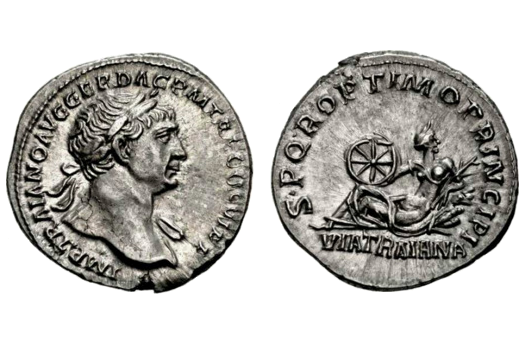
about ancient nomos
Ancient Nomos Art is a museum of galleries exhibiting ancient coins and ancient mint maps. The coin gallery displays the diverse art and history of hand-crafted ancient Greek, Roman, Byzantine, Persian and Medieval coinage. The ancient mints mapping gallery features Greek, Roman, Byzantine, Asia Minor and Medieval mint city regions and territories. Visitor's are welcome to explore, study and enjoy Ancient Nomos Art.

Imperial, Roman – 113 AD
Via Traiana
From Ancient Galleries

Obverse: Laureate bust of Trajan facing right, slight drapery over his left shoulder.
Reverse: Via Traiana depicted bare to the waist, reclining left with her head turned.
LEGEND
Obv: IMP TRΛIΛNO AVG GER DΛC P M TR P COS VI P P, Laureate bust of Trajan facing right, slight drapery over shoulders. Rev: S • P • Q • R • OPTIMO PRINCIPI, VIA TRAIANA in exergue. Via Traiana Goddess, depicted bare to the waist, reclining left with her head turned back to right, holding a wheel with eight spokes on her right knee and resting her left arm on roadway stones while holding a branch in her left hand.
The above coin was specially issued by the emperor Trajan and is of great historical importance because it celebrates and commemorates Rome’s vast “interstate” roadway developments throughout the vast Roman empire. This evocative Trajan commemorative denarius celebrates the goddess Via Traiana, and her attributes depicted as the new highway of Trajan’s own construction. She is seen half nude and as a reclining female figure holding a transportation wheel. The commemorative coin is thought to most likely refer to the specific Italian roadway known as the via Trajana, constructed at the emperor’s expense from 109 to 113 AD. The new roadway traversed over 200 miles from Brindisium to Beneventum and largely replaced the old Appian Way roadway. A second major artery, the Via Traiana Nova, stretching from Syria to Egypt, was also constructed at about the same time as part of the runup to Trajan’s offensive against the Parthian Empire. These two Roman roads represent just two of the nearly 400 major Roman highways that covered over 250,000 miles! Many roman roads are now paved over, many are still stone, and many are still used today, including Via Traiana. The denarius obverse depicts the bust of emperor Trajan, facing right. He is seen wearing a laureate wreath and a hint of his royal garments of drapery over his right shoulder. The long abbreviated Latin legend begins at six o’clock and reads clockwise as: IMP(erator) TRAIANO AVG(ustus) GER(manicus) DAC(icus) P(ontifex) M(aximus) TR(ibunicia) P(otestas) CO(n)S(ul) VI P(ater) P(atriae) and is spoken to say, “Emperor Trajan Augustus Germanicus Dacicus, Pontifex Maximus, endowed with power of the Tribune, Consul for the sixth time and Father of his Country.” The denarius reverse features the Goddess of the Via Traiana, seen reclining toward the left and holding a wheel above her right knee. The eight spoked wheel represents her attribute of transportation. The long reverse abbreviated Latin legend begins at about seven o’clock and reads clockwise as: S(enatus) P(opulus) Q(ue) R(omanus) OPTIMO PRINCIPI, VIA TRAIANA, in exergue. The legend is spoken to say, “The Senate and the Roman People, for the best Princeps, and by the Goddess Traiana of roadways.
DOCUMENTATION
Value: Denarius. Metal: AR Silver. Weight: 3.29 grams. Mint: Rome. Date: 112-113 AD.
Attribution: Roman Imperial Coinage, Volume II, 266; Woytek 398b; Strack 179α; RSC 648; British Museum Collection, RE, 487-91; Bibliothéque Nationale, 671 variety (bust type); Photo courtesy CNG LLC, Triton XXIII, 720 (this coin).
Legend, Documentation and Attribution
